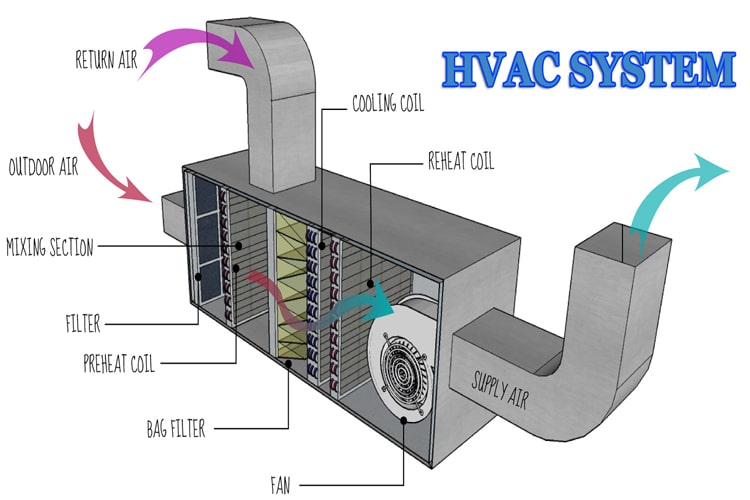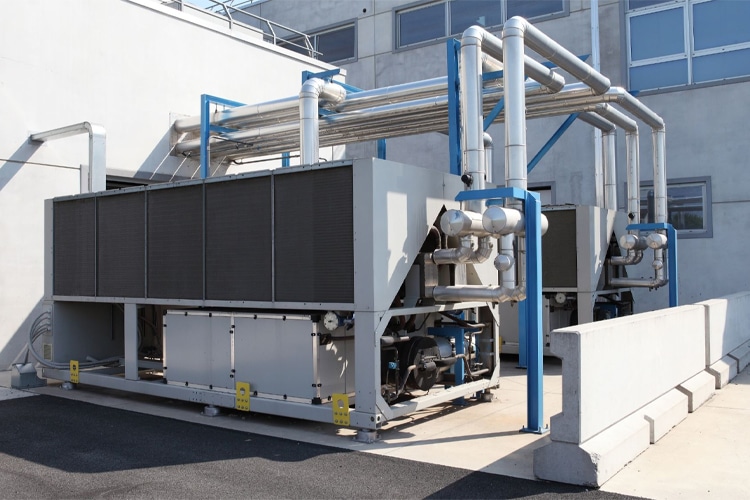
HVAC has recently become one of the most curious ventilation systems in Turkey. Interest in the HVAC system seems to increase as the high-rise, small-window home styles of modern construction spread. So what is HVAC? Is it suitable for every home and every workplace? How is it different from the air conditioner? How does it work? What are the HVAC system types? The answers to all your questions and more are below.
What is HVAC? What does it mean?
Heating, Ventilating, Air Conditioning (HVAC) stands for heating, ventilation and air conditioning. Combining the initials of these words, the term HVAC is used as an industry abbreviation. HVAC refers to air systems used to heat and cool both residential and business premises, as well as to allow air flow between the indoor and outdoor space. HVAC keeps you warm in the winter and provides coolness and refreshment in the summer. It also balances the indoor air with its filtering and cleaning system to provide a healthy environment and keep the humidity level at the best level.
How does HVAC work?

There are instances where HVAC components may operate independently of each other. But more common is that each component works in conjunction with the others. These so-called “combined systems” include both central heating and air conditioning systems. The purpose of an HVAC system is more than just heating or cooling the space.
It serves to optimize indoor air quality and provide the same environment for everyone in the apartment. While HVAC systems have different types of systems (which we’ll discuss below), all systems work on the same principles.
The role of this ventilation system is to regulate and improve indoor air quality.
Mechanical ventilation removes stale and polluted air from a house or building and replaces it with fresh air. Installing or upgrading an HVAC system to provide mechanical ventilation throughout a building can provide several health benefits.
Using the HVAC system regularly; It can help relieve symptoms for those who are sensitive to airborne particles in general, especially those with asthma. By operating one of these systems 24 hours a day, the air quality in homes can be significantly improved and even a better night’s sleep can be achieved.
HVAC principle: A mechanical system that moves air in and out
First, there is a source of fresh air intake from the outside or inside the house. Natural ventilation is available in most homes and refers to the way air typically moves in and out through windows, doors, vents, and other openings. This air exchange is necessary to replenish oxygen and remove odors, carbon dioxide and excess moisture. Mechanical ventilation uses a mechanical system to move air in and out.
Houses with windows shrinking with modern construction need HVAC system

In the past, most homes had plenty of natural ventilation through gaps and cracks in the construction, with doors opening and closing. HVAC systems are becoming popular in new construction as modern construction focuses on homes with smaller windows and boxes than older homes. Therefore, ventilation is an increasingly important component in homes. After the air is taken in, it is drawn into an air handling unit where the work begins. Here, air is drawn through the filters to remove dirt, dust, allergens and other particles.
The system uses outdoor fresh air to provide high indoor air quality.
The V in HVAC or ventilation is the process of replacing or replacing the air within a space. The system uses outdoor fresh air to provide high indoor air quality. This ensures a better quality air indoors and includes the removal of humidity, smoke, odors, heat, dust, airborne bacteria, carbon dioxide and other gases, as well as temperature control and oxygen supplementation.
The air is either sent to be heated or sent to be cooled and remove excess moisture. It is directed home when the air is clean, fresh and at a comfortable temperature. For central systems, this means moving from a network of channels and recordings to different rooms. For other systems, this usually means being redirected directly to the field.
What does an HVAC system include?
A basic HVAC system consists of a heating unit, a cooling unit, and a duct to move heated or cooled air. Generally, an oven serves as a heating unit. Whether the furnace runs on natural gas or electricity, its efficiency is measured by the Annual Fuel Use Efficiency ( AFUE ) rating, which shows how much fuel is converted into heat. A furnace with an AFUE rating of 95% converts 95% of the fuel supplied to it into heat. Today, the minimum acceptable AFUE rating is 80%.
So what are the types of this system?

Each system varies depending on a home’s heating and cooling needs, its location, age, existing ductwork, heating and cooling needs, and other factors.
Split system: Split system , also called forced air system, has a unit inside and outside the house. This setup can consist of a furnace and air conditioner, an air handler and heat pump, or a furnace and heat pump. Which configuration is best for your home will largely depend on where you live. For example, a furnace and heat pump setup works best in very cold climates.
Hybrid heat pump: In this scenario, the central heating system includes an electric heat pump working in conjunction with a furnace. During milder times of the year, such as spring and autumn, the heat pump heats the house. In temperatures that are too cold for a heat pump to operate effectively, the furnace is activated. Also known as a dual fuel system, this hybrid system saves money as it costs less to heat the house with a heat pump than with a stove.
Ductless mini split: This type of ductless system is usually best for small spaces such as garages and workshops that do not require a traditional split system. They are not suitable for all household applications. Typically, these systems are easy enough for the homeowner to install themselves.
Ducted mini-split: A ducted mini-split system uses tubes instead of larger ducts to move air from an outside compressor and condenser to a room. This solution is best for homes that don’t have much room for conventional ducts. Compared to ductless mini split systems, ducted mini splits have the advantage of better air circulation.
Packaged system: A packaged system contains the traditional components of a split system. However, all units are located outside. This solution works best in homes that do not have space for a domestic heating unit. Even if you have space for a split system, you may want to consider a package system as they are quieter (everything is located outside the house) and have lower installation costs (there is only one unit to install).
What is the difference between HVAC and air conditioner?

This may be the most curious question for those who do research on the HVAC system. So what exactly is the difference between HVAC and air conditioning? This ventilation system and air conditioner are often used interchangeably. However, the terms actually mean two different things. When an HVAC system consists of several components working together to regulate the temperature and ventilation in a building, air conditioners simply cool that building.
Think of it this way: An HVAC system can include a furnace, ductwork, air cleaner, smart thermostat, and air conditioner, while a central air conditioner is just an air conditioner. In other words, an air conditioner may come under the HVAC umbrella, but not all HVAC systems actually have an air conditioner.









